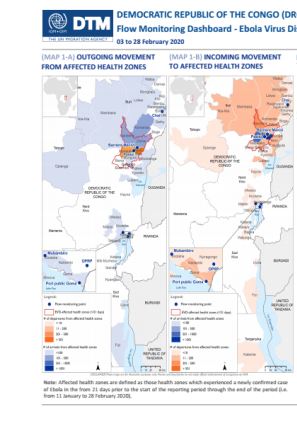-
Countries
-
Data and Analysis
-
Special Focus
-
Crisis Responses
DRC — Flow Monitoring Dashboard - Ebola Virus Disease (EVD) (3-28 February 2020)

Contact
DTM DRC, iomdrcdtm@iom.int
Language
English
Location
Democratic Republic of the Congo
Period Covered
Feb 03 2020
Feb 28 2020
Activity
- Flow Monitoring Survey
- Flow Monitoring
- Points of Entry (PoE)
Over the reporting period of February 2020, a total of 38,457 movements were observed at sixFlow Monitoring Points (FMPs) at Points of Entry (PoE): Lengabo, Pasisi, Pont Loya, Mubambiro, OPRP, and the Port of Goma (Fig. 8). These locations were chosen strategically for the protection of major population centres, the monitoring of cross-border movements, and the monitoring movements between affected and non-affected zones. Data from WHO and the Ministry of Health shows that two health zones were affected during the period, Mabalako and Beni. An affected health zone is defined as any health zone that reported a confirmed case of Ebola Virus Disease (EVD) from 21 days prior to the start of the reporting period (i.e. from 11 January to 28 February 2020). From 11 January to 28 February, two-thirds (68%) of new confirmed cases were reported in Beni health zone, with the rest in Mabalako. Of the 7,043 movements observed to, from, through, or within affected zones, roughly half (53%) of movements identified were internal, within affected zones. DTM identified 1281 outgoing movements from affected health zones (18%) and 1946 incoming movements to affected areas (28%), while 74 movements (1%) were transits through affected zones, and the remainder (53%) internal (Fig. 1-B). Most of the outgoing travelers from affected zones departed from Beni (76%), while a minority departed from Mabalako health zone (24%). Major reported destinations for outgoing travelers from Beni included Mandima (37%), Bunia (22%), Komanda (11%), and Rwampara (9%) heath zones. Those departing Mabalako health zone primarily reported Katwa (20%), Butembo (18%), Oicha (23%), and Komanda (10%) as their intended destination. Only one traveler observed coming from or transiting through an affected zone reported their final destination as outside of DRC . Travelers from affected zones reported 58 individual transits (a 5% rate) in non-affected zones. Motivations for traveling varied greatly by the movement type, with forced displacement due to conflict appearing to have played a disproportionate role in motivating movements into affected zones, while seasonal migration disproportionally motivated outgoing movements (Tab. 1-B).
